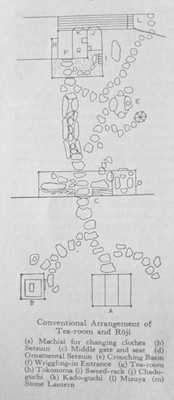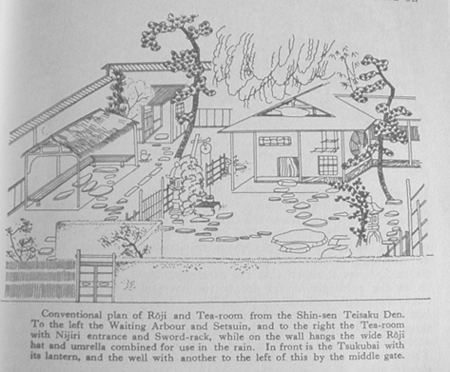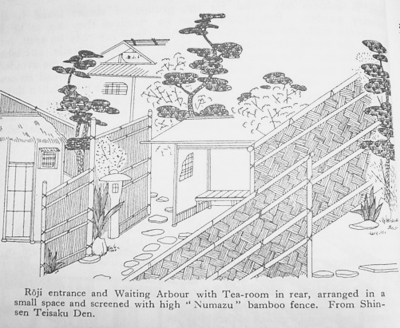THE ROJI
露地(ろじ)
Roji is the name given to the garden of the Tea-room. It means Dewy Ground according to the spelling. It differs from the ordinary garden in being only a passage, and is made as simple and unornamentual as possible. No feature in it should be particulaly prominent, and it should have a natural unastentations appearance.
露地とは茶室の庭のことです。 読んで字のごとく露(つゆ)の路です。それは単に通行するための普通の庭とは異なり、可能なかぎり、非装飾的なシンプルを追求して作られています。特別な目立つ特徴が無く、虚飾のない自然な姿を形作ることなのです。
It is now generally divided in two parts, the Outer and Inner Roji. In the Outer Roji is the Machiai or Waiting arbour and the Setsuin or Privy, while Inner, separated from this by the middle Gate, is the garden of the Tea-room. There are various styles of Roji, but in all the introduction of ornamental trees, artificial grouping of trees or stones, the use of stones of a peculiar shape or anything suggesting prettiness or expence are out of place.
それは普通二つに分けられ、外露地と内露地です。外露地は待合と呼ばれる外腰掛やお便所が設けられていて、中門という門があり、それより先が内露地です。様々な種類の露地がありますが、奇麗に刈り込まれた木々、石や樹木の人工的な景色、独特な形の石の配置など、何か別の世界を提示しているかの様です。
The feeling should be of a simple mountain path of some character, made of ordinary trees and stepping stone in an interesting manner.
さまざまな形をした木々や石、山の小路を想像してみてください。ごく普通の木々が植えられ飛石という石が置かれていますが、それはけして雑然と配置されているのではなく、重要なマナーが存在しているのです。
It symbolies the pure Buddha world where host and guest may meet in frank and quiet friendship. Thick green moss, all pure and sunny warm, was Rikyu`s answer when asked to describe the ideal Roji.
それは仏様の世界を象徴し、亭主と客が気取らずに平穏な交友を結ぶ場所を意味しています。 青苔日厚白無塵、「厚い緑の苔は清く、日のあたる暖かさ」これは利休が露地について尋ねられた時に答えた言葉です。
His own Tea-room at Sakai was so placed that he could get a glimpse of the sea between the trees when he stood by the water basin. This was arranged in accordance with the verse of Sogi, which he very much admired, "A glimpse of the sea through the trees, and the flash of the stream at my feet." And the feeling that is to be aimed at in the Roji is very well expressed by his own verse.
彼の堺に有る茶室はその言葉通り、水盤のところに立った時に木々の間から海がちらっと見えるように工夫してありました。これは彼が敬愛してやまないSogiと言う方の詩「海すこし 庭に泉の このあいだかな」から作り出されています。露地に向けられた思いは彼の歌の中にもよく説明されています。
Since the Dewy Path is a way
That lies outside this most impure world
Shall we not on entering it
Cleanse our hearts from earthly mire?
以来ずっと露地はこのもっとも不純な世界の外側にあります。
そちらに立つことを止め、この世のぬかるみから我々の心を清らかにしませんか?
* The word Roji comes from the Hokke Hiyu-bon, one of the Seven Parables of the Hokke-kyo or Lotus Sutra, where it occurs in the phrase, "Escaping from the fire-striken habitations of the Three Phenomenal Worlds they take their seats on dewy ground." The exprission came to be used of part of the grounds of a Buddhist Temple but never of an ordinary garden. Hence it was that Rikyu selected it to denote the enclosure surrounding the Tea-room. The Sado Dokugan says : " The word Roji in this sense does not originate with Suko or No-ami, neither does it come down from the Tea-classic of Luh Wuh. It is entirely the invention at Rikyu."
露地の語句自体は法華経から来ました。法華経の七つの寓話 Lotus Sutra にこの様な箇所が見られます。「三つの知覚できる炎燃え盛る居住地より脱出するために、彼らは露の地に座る場所を得た」この表現は仏教寺院で使われるもので一般的ではなく、庭の意味ではありません。利休はその意味を解釈し表現するために、茶室の周りを庭で囲いその場所を露地と言う言葉にしました。Sado Dokuganという書物にはこう書かれています。「露地の概念の発明者は珠光や能阿弥ではなく、同様に茶の祖陸羽でもありません。これは完全に利休の考案によるものです。」
Originally there was no Roji, according to the Izumigusa : One entered straight into the room. It was all rather simple and seuere. Ikei said " the outer Roji and arbour is a complication and not according to the simple style. It did not originally exist and the guests came when they pleased and entered the Tea-room directly. In the days of the Shougun Hidetada, Kanemori So-un first had one made and now they have become common. There is a difference between the outer and inner Roji. The outer has no special character but is narrow and dark, but when one opens the Nakakuguri and enters the inner the scene should chang. The outer gate of the outer Roji is left a little open when ordinary guests are expected and they come in and enter the arbour.
和泉草と言う茶書には露地についての記述はありません。まっすぐに茶室に向かうこと、簡素と遮断がすべてにまさると書いています。怡渓和尚は「露地と待合は複雑極まりなく茶の言う簡素とは別である」っと書いています。もともと実在するものではなく、客が満足しそして茶室に直接入る時に初めて理解する世界である。徳川二代将軍秀忠の時代、金森宗和と言う人が利休を理解してまず作り、後、それが一般的となったのです。外露地と内露地には違いがあります。外露地を入り、中くぐりと言う門を通って内露地に入るとその雰囲気一変するように作られています。外露地の戸は左に少し開きお客は案内され、待合という小屋の中へ入ります。
Hosokawa Sansai says in the Chadansu : the Roji should be natural, and so it is not easy to lay down any rules about it. All depends on hte situation and one may gauge the charecter of the host from its appearance. It shows want of taste if it appears short and shallow and as though made to lead straight to the Tea-room. The best feeling would be though it seemed to lead round to the back of the house or some where else so that you come on the Tea-room accidentally. It should have a sense of depth and remoteness.
細川三斎は茶箪笥という書物の中で言っています。露地は自然でなければならず、そして、さまざまな約束事のために簡単であってはならない。その時次第、臨機応変に、そして、亭主の意を的確に反映させ、しかも、標準の寸法に合わせる。その意とは風味であり、くどくなく、あたかも茶室に一直線に導くがごとく。あたかも家の裏へでも案内するように、何か違う場所へ偶然迷い込んでしまうようにすること。深い感性と人を導く能力を身につけなければならない。
On entering the Inner Roji the aspect should be quit different from that of the Outer, where no particular inpression need be made but one of absolute cleanliness. The path across it to the Tea-room does not go straight through the center, but divides it into two unequal parts.
外露地から内露地へ入る過程において、様子は一変します、しかも、何か特別な印象を持たせること無くです。そして、もちろん清潔であることは当然です。茶室に向かうのにも、直線的に庭を横ぎるのではなく二つの不揃いの物をつなげて行きます。
Here it is usual to emphasise certain points by the arrangement of these will differ according to the size of the Roji : five may be the averabe, but for a smaller space three will be enough, while if large seven or even nine may be used.
それは通るところを強調するためのもので、露地の大きさによってその配置も異なります。平均は約五ヶ所で、小さい場合は三ヶ所大きい場合は七もしくは九ヶ所も使われる場合もあります。
These points are the Nakakuguri or Middle Gate, the Stone Lantern, the Water-basin(either one or two), and the entrance to the Tea-room. The Outer Roji is generally sanded, while the Inner is mossy. Rikyu liked his Roji to suggest a mountain path after rain, and used pebbles to get this effect. He preferred pine-trees and bamboos and eleguns pungers, while Oribe has a liking for firs, since he liked the somber digmity to those ancient trees at Sojo-ga-dani.
その物とは中くぐり又は中門、石灯篭、水盤、そして茶室入り口です。外露地は不通は砂が敷きつめられていて内露地はコケで覆われています。利休は雨が上がったあとの山道を歩く感覚を表現し、そして丸い小さな小石を使うことによって人生哲学を現しました。利休の松の木と竹をつかい流麗で刺激的な庭なのに対し、織部はモミの木を使ったりSojo−ga−daniの古木を使うなど薄暗い尊厳的な庭になっています。
* Sen Sojun in Cha-zen Doitsu mi states that Roji was originally only a name for the Tea-room and means that place where the real mind is revealed and all attchment put away. In this case Ro= arawasu, to reveal ( as in rokotsu and roken ) and ji is equivalent to kokoro, mind. So it is also called Haku-roji, white, signifying clear or pure. Its application to the garden of the Tea-room he considers a mistake the crept in later. This would easily lead to the spelling ji = michi, path.
茶禅一味と言う言葉があります。その中で露地とはもともと茶室そのものの事でした。すなわち、悟りを明らかにしてすべてを取り除き無となる場所と言う意味です。例えば"露"と言う字は"あらわす"と読め明らかにすると言う意味があります。露骨、露見などという熟語があり、心や気持ちをあらいざらいさらすと言う意味なのです。加えて、白露地とも呼ばれ、白、聡明や純粋を意味します。茶室の庭のしつらえは、ゆっくりとゆっくりと歩くためのものではなく道の概念を表しているのです。

Water may in some cases be introduced, so as to suggest, for instance, a mountain valley with its cascade, or the path by the side of lake, but it should not be elaborated to the same extent as in the ordinary landscape garden. Since the Roji is a garden composed almost entirely of stepping-stones, there is seldom any need for the groups of stones found in an ordinary garden. But should these be required they are to be in accordance with the same rules.
水の利用についてもいくつか見ることができます。例えば渓谷の滝や湖畔の路などの景観です。しかし、普通の庭の風景のような大きさに作ることはしません。露地は言いかえれば飛石で構成された庭と言うことができます。それはその石を伝っていく物と言うだけではなく、調和という言葉の中、同質の規則性があります。
What these are may be seen very well in the excellent "Gardens of Japan" by Jiro Harada, published by the Studio. The same three kinds of stones too are to be avoided : "Disaased stones," i.e those distorted at the top : " Dead srones," or horizontal ones that look loke vertical ones that have fallendown : "Pauare stones," or those that stand about by themselves without any relation to others.
この事はthe Studioから出版されたHarada Jiro氏によるGardens of Japanと言う本の中に素晴らしい内容で書かれています。それによると、次の三種類の石は避けること、一つ目は「病的な石」と名付けられてっぺんが歪んだもの、二つ目は「死んだ石」と名付けられ縦横角張ったもの、三つ目は「貧困の石」と名付けられ他と無関係にぽつんと立っているものです。
Thus the Roji may be regarded as in some sort the originalform of the Japanese domestic garden, modelled on that of the Zen temple and apart from the larger Island and Lake from attached to the residence of a noble. Its small size and harmonieus proportins and simple suggestiueness have therefore supplied a model that can be employed to lend simple distinction to the smallest space.
このように露地は日本固有の庭方式だと考えられます。禅宗のお寺や貴族階級の屋敷の広大な池やその浮島等をモデルとして作られました。そこから、その縮小化やハーモニーの妙、シンプルな暗示性と狭い空間を最大限活用して一つのモデルを完成させることに時間と精力を費やしたのです。
It is just this that European gardening lacked, for everthing had to be the cud-duwn version of the mantion pleasance, except that charming specimen the cottage garden, which owes its excellence to its haveng been simply for use.
この事はヨーロッパの庭にはけしてありません、邸宅の遊園を小さくしていく改良などありえないのです。ゆういつ有るとすれば、それはコテージでしょうか、自然や簡素を満喫する施設です。

Shin-sen Teisaku Den と言う一般的な露地と茶室。向かって左側には待合とお便所、左にはにじり口と刀掛を備えた茶室、さしかけ屋根があり雨の時に傘の支度が出来るようになっています。手前にはつくばいと石灯篭、向かいに井戸があり左横に中門があります。
As to the stepping stones of the Roji they should be laid so that they are easy to walk upon, but not in a straight line, for that would be uninteresting. At the same time they must not be so irregular as to appear artificial. They should look as though they led naturally through the trees with which the Roji is planter. The stones themslves are not selected or valuable ones, but rather the reverse, for in making the Roji the aim is to obtain an interesting effect by the skilful arrangement of intrinsically valueless things. If the stones are large enough to receive the foot that is sufficient. Rikyu has laid it down that the arrangement of these stones should be on the principle of six pointsfor use and four for appearance, but Oribe would reverse the proportion. Stepping stones are usually laid in groups of the three and four, but abbreviated groups of two and three are not inadmissible.
飛石をわたるにあたり自然で簡単に歩けるようにしなければなりませんが、さりとて、直線的に通るわけでもありません。それに、人為的に見えるようでもいけないのです。石そのものは多趣雑多、しかし、逆もまた真なり、、露地を作ると言うことは、内在的な価値のない、こだわりの積かさねという極めて興味深い結果を見ることです。石の大きさは足が置ければそれで十分です。利休はその原理を「渡り六割景観四割」と言いました。織部は逆に「四割六割」と言いました。置きかたは普通三個か四個の集まりでならべられています。但し、二個か三個に省略されていても許されます。
Stones of the same size are not laid in succession, nor are any ever laid lengthwise in the line of the path. There is no rule about the distance between them except that it should allow of comfortable walking. Opinions differ among the different schools as to their height above the ground. The Sen school says two inches, Oribe an inch and a half, and Enshu one inch. Label stones or flat slabs laid side by side partly overlapping are often seen in a Roji. They are generally one foot two inches wide by three feet long. Another way of varying stepping stones is to use a long step occasionally made of stones set in mortar. Sometimes these stones are flat ones of different size or large ones varied by insertions of pebbles. These long steps were first used as path inside the gate of the Daitouji, and from this Rikyu tooks the idea and adapted them for the Roji. It may sometimes improve the scenery of the Roji to lay a stone of interesting seems to be needed and where a tree cannot be planted. Especially if a stone that will not bit in any where else can be found.
同じ大きさの石は渡る順番において、けして同じ大きさを続けて並べることはありません。石と石の間隔に特別な決まり事はありませんが、やはり歩きやすいことが第一です。地面からの石の高さが流派によって違いがあるのが面白く、利休流は約5cm、織部流は約3.7cm、遠州流は約2.5cmです。平石を端から重ねて敷き詰めたものも露地でしはしば見うけられ、大きさは約1.2m×約35cmです。その他のものとして、漆くいで石を埋めて渡りを作ることや小石を集めて石として配置したりしてものもあります。京都大徳寺の門の通りに長い渡り石があり、利休がそれを露地へ応用しました。飛石は露地の景色の重要な場面(樹木が無い場の代わり)として改良がなされてきたのだと思います。他では見ることはない独特の一つの石の役割なのです。
Beside the stepping stones there are the three other groupings to be considered. Those at the Middle Gate and those at the Wriggling-in Entrance of the Tea-room, and those in the Waiting arbor in the Outer Roji.
くわえて、中門の所、茶室のにじり口、外露地の待合にそれぞれの飛石のグループがあります。

露地入り口と待合の裏、小さなスペースに沼津垣という竹で編んだ塀があります。
Outside the Middle Wicket there is a stone big enough to stand on, so placed that its surface is about a foot below the level of the threshold of the gate. This is called the Guest Stone. On the inside is another similar flat stone, slightly larger and higher, called the Crossing Stone. These should be separated from the gate by a space of four or five inches and three inches respectively. It does not matter with is the nearer as long as the spaces are not equal. Next to the Crossing Stone is another like it, but a little smaller on one inch lower, caller the Host Stone, and beside this is placed a small stone known as the Lantern Stone, for the hand lantern carried when Cha-no-yu is given a night.
中くぐり門の外側には上に立つのに充分な大きさの石が置かれ、だいたい門の敷居の幅ぐらい縦は一足幅ぐらいの大きさです。客人石と言います。内側にも同じような大きさで少し高めに敷かれていて乗越石と言います。二つの石は門を挟んで4〜5インチ(13cm前後)のスペースがあり、それぞれは3インチ(約8cm)ぐらいづつ離れて敷かれています。たいした問題ではありませんが、大きさはだいたい同じようなものが使われています。次にある石も同じようなもので少し小さめで低く敷かれていて亭主石と言います。横には手燭石(てしょくいし)があって、夜に茶の湯を催すときに使われる手燭(てしょく)を置く石です。
At the Wriggling-in Entrance of the Tea-room there is a group of three stones. The one nearest of the room, set six inches from the skirting-board, is large enough to stand upon comfortably and is four inches high from the ground, leaving a distance of one foot two inches from its upper surface to the top the lintel of the entrance. This is called the Treading Stone.
茶室のにじり口にはひとかたまりの石があります。入り口にもっとも近い石は幅木から6インチ(15.24cm)のところに置かれていてにじりは入るのに楽な大きさになっています。地面から4インチ(10.16cm)の高さがあり、入り口まくぎとの間隔は1フィート2インチ(35.56cm)あります。この石をにじり上がりの石と言います。
Next to it comes the Falling Stone, an inch and a half lower, and then the Mounting Stone, again an inch lower, so that these two will be two and a half and one and a half inches high respectively. Some say that the stepping stones in the Roji should all be either five inches and six tenths or four and seven tenths apart.
2番目の石を落し石と言い、にじり上がりよりも1インチ半(3.81cm)低くく置かれています。その次を乗り石といってまた1インチ(2.54cm)低くく置かれています。よって、両方の石はめいめいに2インチ半と1インチ半ほどの高さがあることになりますね。露地の飛石は5.6インチまたは4.7インチぐらいが望ましいといわれています。
In the Waiting arbour stones are arranger according to its shape, and suitably dissimilar flat-topped ones are chosen. One of them should be larger and higher than the others and from its apper surface to the top of the seat one foot two inches is measured, the height of the seat above the ground being given as one foot seven or eight inches. This is known as the Chief Guest Stone.
待合石はその形によってアレンジされます。そして、あまり平らではない石が選ばれ、一つが他の石よりも大きくて高さがあるものがあります。客人石といい、待合のいす壁から1フィート2インチ(35.56cm)に置かれます。椅子の高さは地面から1フィート7インチから8インチ(43.16〜45.72cm)あります。

The Arbour (Koshikake) to which the guests retire in the Interval is furnisher with an Andon, a tobacco tray and paper and inkstone for the guests to write their names. In winter, a hand-warmer is provided. In Rikyu's day tobacco was not used, so he laid down no rules for it. The Arbour in the Outer Roji is called Machiai and not Koshikake. Oribe and Enshu developed the Do-Koshikake or Arbour for Distengwished Guests so that they could change their clothes in it and it was styled therefore Ishodo or Attiring room. Their retainers could enter also and assist them.
客が茶事の合間に退く腰掛には行灯(あんどん)、タバコ盆、客が名前を書くための紙と硯が備えつけられ、冬には手あぶりという暖房器具が置かれます。利休の頃はタバコは無く、よって彼はその規定は残していません。外露地にある待合には腰掛はありませんでした、古田織部と小堀遠州の時代になって客を区別するための建物ができました。その理由として、彼らはそこで衣装を着替えたわけで、衣装堂とも呼ばれたりもします。それと家臣達がそこでひかえて待つという理由もあります。
"Under the shade of an ancient grove a bamboo thicket is planted and narrow path made. A bamboo gate (Takeno shiorido) or a plain wooden wicket (Sarudo) leads into it. All is silent and calm. The stone lanterns and water-basin are mossy, and the stepping stones quite natural and untouched. Under the trees bamboo-grass is growing and the leaves of the trees lie as they fall. Oak and pine leaves lie thick on the ground but unmixed with dirt as though blown there by the wind so that the ground is covered everywhere. Only the path is swept. Such was Rikyu's idea of the Roji. Like a hermit's cell". (Cha-fu)
古い木々や竹やぶの中に狭い小道が作られています。竹で編まれた枝折戸や木板で質素に作られた猿戸がその空間へ導いてくれます。しずかな静寂の世界です。石灯篭や水盤には苔がむし、飛石は自然にそこに敷かれています。木々や竹はただそこに育ち、葉が秋の季節のように足元にまっています。枝や松の葉が庭におちていますが、それはけしてゴミのようにばらばらではありません。自然の風がその庭に葉の絵を描いたように感じます。そして、小道だけが濡れています。。。利休の露地に対する感性で、まるで隠者の枯院そのもです。
* Rikyuu had a Roji without any stones. There was a little verandah of boards and bamboo and on this the guests sat and too off their footgear before entering the Sukiya. This Roji was all covered with grass.
利休は石のまったく無い庭をもっていました。木と竹でできたベランダがあり、客はそこで履物を脱いで数奇屋へ入りました。露地は芝ですべて覆われていました。

Fuhaku style Tea-room if two mats with board floor insertions, and waiting room built in.
不伯流、二畳の茶室に待合が一所に作られています。
Oribe's Roji was much like that of his master Rikyu but a little less rough. He thought Rikyu went too far in this direction. He liked a spacious Roji planted with great pines and fir trees and a reed thatched hut visible in the distance. In both outer and inner enclosure there was a seat, the outer one in a square tiled arbour of six mats. Here the guests met and changed their dress if necessary. He used long flat stones interspersed with the steping stones and grouped with smaller ones set in plaster.
織部の露地設計は彼の師である利休に似ていますが、若干の荒さに欠けています。彼は利休とはちがう感性を表現しました。広い露地に大きな松やモミの木を植え、遠くには目立つよしや藁の小屋が見えるようにしました。内露地には椅子待合を作り、外露地には六畳ほどのタイル張の小屋、客が必要におうじて着替えが出来るようにするためです。飛石として長くて平らな石を点在させしっくいで塗り固めた小石集団の飛石なども作りました。
Some of these large stones were four or five feet long. Under the verandahs and in the Setsuin the earth was beaten hard. The lanterns were carved, and for the water-basin he liked an old square box-shaped pine needle out at the top. On the ground he carefully strewed pine needles so that it was quite covered. He did not like the leaves of any other tree. The view from the water-basin or the Arbour should be as of the hills in the distance, and the stones round these two features should, he thought, have a smart and bright appearance.
幾つかの大きな石は4から5フィートほどあります。縁側やお便所の下は固く踏まれた土です。石灯篭は曲線的でつくばいは四角い箱型で古びたものが好まれて、回りには松の葉が撒かれています。庭全体にも松葉が丁寧に撒かれています、他の木々の葉は使われません。つくばいや待合からの景色が丘のように見えて、敷かれた石はスマートさと明るい外観になるように工夫されていました。
A certain Goto in Kyoto had a Tea-room in Oribe style and there was a large lake drawn from the Kamo river across which the guests were ferried to the Arbour of the outer Roji by a boy dressed as an acolyte. On the way he would make them hand over their upper garment (Kataginu or Juttoku) as fare and they would have to enter the Arbour in Hakama only. Cha-no-yu Koji-dan.
茶の湯古事談という書物の中に、京都での正式な茶事の一つとしてGotoと言う表記があります。織部式の茶室、加茂川からひいた大きな池を作り、客は船にのって外待合へと行きます。そのときは修行僧としての着こなしでなければならず、上流社会の上着である肩衣や十徳は手に持ち袴のみではいらなければなりません。
Rikyu always carried water in a bucket to the water-basin in the Roji. He said that the first business of the host in the Roji is water carrying, and of the guest washing his hand. That is what it is for. It is to cleanse oneself from the dust of the world. So in hot weather water gives a sense of freshness, and in winter too one must carry it and wash in it, caring nothing for the cold.
利休は露地のつくばいへは手桶で水を運んでいました。露地での最初の仕事は水を運び客は手を洗うこと、それがすべてだと言いました。これは、世俗の埃を洗い流すという意味があります。暑い日には清涼の意味もありましたが、寒い冬には、まだ客への気配りがなされていませんでした。
Originally guests did not wash in the morning since they had already done so and because there was then no waiting arbour, but now it is always done. Also a bucket of hot water is now set by the side of the water-basin in winter.
当初、客は朝茶事においては手を洗うことはしませんでした。朝なので自宅で準備できたのと待合が無かったからです。しかし、現在はすべて行います。そして、冬にはつくばいの横に湯が入った手桶を置くのが普通になっています。
INTRODUCTION-1 TITLE CONTENTS